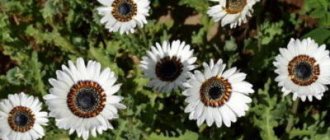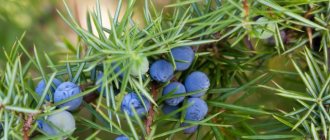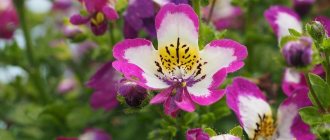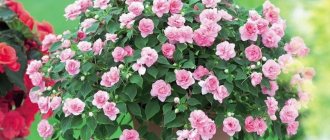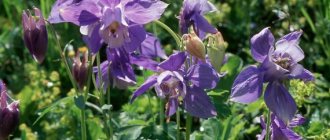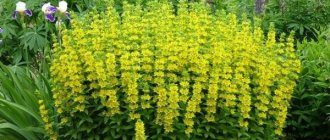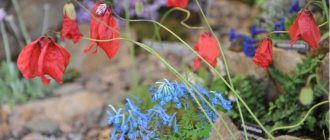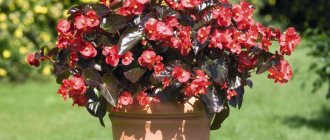One of the most spectacular garden vines, the liana, has fully deserved its status as a “capricious exotic”. True, it is considered a demanding plant not at all because of special care, but because of its low frost resistance. As a perennial, potted plants are grown only by digging them out of the soil for the winter or as a container plant. But in elegance and grace, the visoplodnik knows no competitors. This is a beautiful vine with original fiery flowers, exotic and elegant at the same time.
Eccremocarpus scaber. © Karl Gercens
Fast growing and colorful vines
Among garden vines, which today from the rank of rare plants for growing on supports have turned into real design stars, universal, tireless, allowing you to fill large areas in a short time, there are both boring traditional species and real exotics. One of the latter is the lichen, little known by its botanical name ecremocarpus. These are fast-growing perennial vines native to Chile that are grown as annuals throughout the world. Beautiful foliage and abundant flowering in no way detract from the grace of the plant, one of the most graceful of the openwork steeplejacks.
Visloporpniki , or Eccremocarpus , or Eccremocarpus (Eccremocarpus) are creeping herbaceous perennials, reaching a height (or rather, length) of at least 2-3 meters. Despite the fact that this genus includes 4 species of plants, only one species is grown as an ornamental crop - Eccremocarpus scaber .
This is a very elegant species, producing almost straight thin lashes, delicate and elegant, curling beautifully along the support. It is able to cling to almost any support; tiny but numerous antennae ensure its reliable grip. Even in one-year cultivation, the rough plant can reach a height of up to 5 meters. The vine itself seems airy and weightless. But despite its apparent fragility and delicacy, the lichen carp perfectly protects from the wind and creates continuous coverings that protect from prying eyes.
The leaves are complex-pinnate, sit opposite, consist of 3-7 small lobes, giving the crown a delicate, curly and weightless appearance. The dark, rich color only emphasizes the beauty of the foliage. It is difficult to distinguish individual leaves in the “carpet” of the lichen; the greenery seems to “ripple” in the eyes. On the edges of the leaves, emerging from the central veins, there are branched tendrils, inconspicuous at first glance. A liana develops from tubers.
The luxurious lacy greenery of the plant is not inferior in beauty to flowering, but it is the beauty of the latter that is considered the best characteristic of the vine. Graceful, small tubular flowers, painted in fiery colors, are collected in loose clusters of inflorescences at the very ends of the branches. They are located opposite the foliage, making them stand out even more against its background. The tube is narrow, the throat is almost closed. The flowers appear as strokes, splashes, scattered across the openwork background. After flowering, greenish fruits, similar to spears or mini peppers, begin to ripen in August. The formation of fruits in place of fading flowers negatively affects the abundance of flowering.
The color palette of the potted plant includes only fiery shades - red and orange in various bright combinations, often mixed together in variegated flowers.
The flowering of this vine continues for a very long time, taking at least 2.5 months - from July until the arrival of the first frost. And if the greenery withers under frost, then the flowers are not afraid of the first cold weather.
Eccremocarpus scaber. © Michael Wolf
In addition to the basic plant, breeders have developed improved garden forms of the lichen. They differ from the base plant in color and more abundant flowering. Decorative forms of the rough lichen:
- 'Tresco Scarlet' is an orange-red, bright variety with a yellow throat and a red base of the tube;
- 'Tresco Gold' is a beautiful vine with golden, shining flowers in denser clusters;
- 'Tresco Rose' - a showy, variegated variety with cherry-tinged pink flowers and a bright orange throat;
- 'Tresco' mixed color;
- Salmon variety with beautiful golden edges 'Pink Trumpets';
- Charming golden-flowered variety 'Aureus'.
Varieties
The most commonly grown plant in our country is the rough plant. It is characterized by rapid growth and, under favorable conditions, reaches a length of 3-5 m per year. Inflorescences of yellow, orange and red tubes densely cover the vine. The size of the brushes is about 15 cm. Flowering occurs from early July to mid-October. The leaves are petiolate, unpaired, collected in 5-7 pieces. Spiral-shaped antennae extend from the base of the petiole. Fruits similar to hot peppers begin to form from the end of August. Depending on the color of the flowers, the following varieties of beetroot are distinguished:
- TrescoGold – golden and yellow tubes are collected in an inflorescence;
- TrescoRose – flowers of rich cherry pink color with a golden hue at the throat;
- TrescoScarlet - scarlet and orange flowers with shades of ocher in the throat.
Rough horned carp
Among the latest achievements of breeders, one can highlight the Sashiko horned carp variety. It is distinguished by dark green carved foliage and bright small flowers. Glossy tubes of orange and red colors reach 15-20 mm in length.
Orchard sashiko
The use of lichen carp in garden design
Visloporpnik is one of the most exotic vines for decorating various supports, protecting resting places, creating colorful screens, camouflage and vertical draping. It looks great on a fence, trellis, gazebo, arches and even the walls of a terrace, house, or shed. The beauty of the ecremocarpus in the background, as an openwork background, is especially revealed.
The plant will grow equally well in the garden, on the balcony, and on the terrace. The main thing is to choose a warm, bright location for it. At the same time, the vine can be used for temporary decoration (for only one season), and as an original permanent soloist in potted gardens and decorative compositions.
Decorative use
Visloporpnik is a rare plant for our country, beautiful and exotic. It is most often used for vertical gardening of the southern walls of houses, sheds, gazebos and terraces. Eccremocarpus is valued for its lacy foliage and bright, showy flowers. Its decorative effect lasts throughout the season until autumn frosts.
Joint cultivation of two varieties of blueberry
Plants look interesting as decorations for mesh fences. It is also possible to grow them together next to rose bushes, lilacs and other shrubs. The plant will be able to use their stems as supports. Such a neighborhood looks attractive and unusual.
Strategies for Growing Potato Carp
In its homeland, the vine renews itself annually thanks to its large rhizome, but the tubers are sensitive to frost and overwinter only at temperatures above 0 degrees. Only gardeners in regions with very mild winters do not have to worry about how the willow carp will overwinter in the garden. For the middle zone, this crop is too sensitive, and a vine with little winter hardiness will have to not only be covered, but put in a frost-free room.
It is most convenient to grow lichen carp in large containers. This makes it easier to ensure stable soil nutrition and the watering the plant needs. But you can plant seedlings directly in open soil.
3 Strategies for Growing Potato Carps:
- As an annual liana - with sowing seeds for seedlings and transferring young plants to open soil or containers.
- As biennials, sown in late summer or early autumn in cold greenhouses, overwintered in a frost-free room and planted in the garden the following year.
- As a perennial plant that is removed indoors for the winter.
Eccremocarpus scaber. © Christian von Bohlen
Description and photo
In its hot homeland, Chile, the plant forms flowering vines tens of meters long. In our northern latitudes, the liana does not overwinter, so the crop is grown as an annual. Despite the short growing season, she manages to grow vines up to 3 m long.
In June, the plant begins to bloom, and until the coldest weather, the bush is generously strewn with clusters of tubular bright flowers. The length of the flowers is 2 – 2.5 cm, the colors are bright, eye-catching: bright orange, red, yellow. In August, brownish pods filled with seeds ripen from them.
Rough lichen is a species characterized by its unpretentiousness and rapid growth. During the summer season, the vine reaches a length of 4–5 m. The plant is successfully planted to decorate gazebos, pergolas, and fences. Tendrils growing on a flexible stem cling tightly to supports, and in a short time cover large areas with a picturesque carpet. Dense openwork foliage forms a wall impenetrable to prying eyes.
Popular varieties
The inflorescences in the form of racemes reach a length of 15 cm, the color of the flowers varies depending on the variety:
- Treskold (golden),
- Treskorose (dark pink with golden throat),
- Codfish (bright red and orange),
- Sashiko (orange and red shiny ones, look great against the backdrop of dark green foliage).
The flowering of the rough lichen begins in early July and lasts until frost.
Conditions required for ecremocarpus
Potato fruits do not tolerate getting wet very well, especially during the flowering period. Therefore, the vine is placed in places where it will be protected from precipitation. When growing in containers, finding a comfortable location will not be difficult. But when planting in the ground, it is better to choose the most protected, secluded corners. As for lighting, it should be the brightest for the viper. Sunny locations, walls and south-facing slopes in the warmest places in the garden are the best places for this vine.
You need to carefully select the soil for the lichen. This vine is suitable for loose, moist and loamy or sandy loam soil (or better yet, sandy-clayey soil). It is especially important to ensure high soil fertility by adding an additional dose of complete mineral fertilizers and organic matter before planting. The substrate for containers is selected from among loose universal soil mixtures.
Planting viscarp
Seedlings of vines in a permanent place or in large containers for the garden and terrace are carried out only in May, after the threat of return frosts has passed. Eccremocarpus is placed at a distance of 30 cm between plants: it has a compact rhizome, it is a tuberous plant that does not need much space.
Before planting vines, you must add organic fertilizers to the soil. When planting seedlings, it is better to keep the soil ball intact. In containers, thick drainage is placed at the bottom of the container. The procedure should be completed with abundant watering and mulching.
Eccremocarpus scaber. © FarOutFlora
Caring for the grosgrain
Growing ecremocarpus without watering is very difficult. This exotic vine, both in containers and in the soil, requires constant soil moisture. Systemic watering is not required, but even small droughts are best compensated for with moisture. Of course, ecremocarpus growing in tubs and containers is watered regularly, in the summer - daily or more often.
The plant will also need additional feeding. For container planting, they are applied weekly, using complex fertilizers for flowering plants or any mineral fertilizers. The procedures begin from the moment they are planted in the soil or transferred to the garden and continue until August. For potted plants growing in the soil, apply 2-3 additional feedings during the active season - a month after planting, at the budding stage and at the very beginning of flowering. Another strategy you can use is to apply fertilizer twice a month. For this vine it is also better to use complete mineral mixtures or fertilizers for flowering ornamental plants.
For those who love stable conditions for growing lichens, it is better to ensure that the soil is mulched. All plant materials and decorative mulch are suitable for this vine in any form of cultivation.
Eccremocarpus forms a huge number of small antennae that cling well to support. But the shoots themselves still need to be guided, tied up, and “intercepted” as they grow, so that the shoots can more actively climb up the support.
In order for the florist to bloom tirelessly and really delight with its fiery bells from May to October, it will be necessary to regularly remove fading inflorescences and not allow the inflorescences to ripen. But the main guarantee of lush flowering is timely pruning. In order for the plant to actively develop, reach large sizes, and show off large inflorescences, it is necessary to shorten the long shoots even before taking it back into the garden.
Eccremocarpus scaber. © FarOutFlora
Growing and care
Visloporpnik prefers sunny places.
It is grown in rich garden soils. It has no acidity requirements. A drainage layer is required. To make the plants look more decorative, they are tied up and directed. During the period of intensive growth, ecremocarpus need abundant watering. Feeding is also important for them, which is carried out weekly from spring until August. Visloporpnik: flowers and buds
When growing wildflower in a container, you need to fertilize even more to ensure proper growth rate and flowering intensity. If possible, containers can be brought indoors for the winter. In winter or early spring, plants should be trimmed back slightly to achieve the desired shape. In this embodiment, ecremocarpus can be grown as a perennial.
Visloporpnik practically does not get sick and is not affected by pests.
Joint planting with roses
Overwintering
You can save the vine for next year only by moving it indoors in containers. When digging up potted plants growing in soil, it is advisable not to destroy the soil coma around the tuber. Before taking the plant away for the winter, the shoots are shortened. Luxurious lichens should overwinter in a cool, but not too cold, room. The optimal wintering temperature for this vine is from 5 to 10 degrees Celsius (maximum 15 degrees). But the main parameter is not temperature at all, but access to light. In order for the lichen to retain its beauty and not wither, it must be kept in a bright place even in winter.
Outdoor care
The plant is moisture-loving, but does not tolerate stagnant water. Water the lichen often, but little by little, only with warm water at the root.
Starting from the budding phase, the vine is fed with solutions of mineral phosphorus-potassium fertilizers once every 10 days.
It is necessary to monitor the rapidly growing shoots, guiding them along the supports in time. To prevent the plant from becoming overcrowded, thinning pruning is performed.
The vine does not suffer from diseases, but young shoots can be attacked by aphids. If the pest is noticed in time, it is not difficult to overcome it by spraying with appropriate preparations.
With the onset of the first frost, the foliage dies. Seeds on a bush rarely have time to ripen in the middle zone, so in the fall the branches with fruits are brought indoors and simply placed in a dry vase or the “sheaves” are hung up to ripen. The seeds will be ready in about a month.
In the southern regions, where winter temperatures do not fall below 0, the lichen can be left to overwinter in the soil. The entire above-ground part of the vine is cut off, and the bush is covered with peat, sawdust or leaves for insulation.
Another option for preserving the viper as a perennial in harsh winter conditions. This is digging up the entire bush and storing the roots, along with a lump of earth, in a pot. The pot with the vine is stored in a bright and cool place (+8...+12 degrees). The soil for a wintering plant is moistened with water no more than once every 2 weeks.
Tags:lianaannualseedlings
Visloporpnik is a very beautiful fast-growing vine, abundantly decorated with red, orange or yellow tubular flowers. In just one season it will weave around a wall, a small gazebo or a hedge. Thanks to this, the garden amazes with a riot of greenery and a pleasant aroma, turning outdoor recreation into a small fairy tale.
The homeland of the Eccremocarpus or Eccremocarpus is Chile. There it grows as a perennial and manages to spread over several tens of meters. In our country, it does not withstand harsh winters and is grown as an annual. This does not prevent you from getting abundant growth; in just one season the vine grows 3 m or more.
A small genus of lichen belongs to the Bignoniaceae family. Its root system is fibrous, superficial, and when grown for many years it forms a tuber. Small tendrils form on the stem, which helps the vine to cling to support. The petiole-pinnate leaves are located oppositely on the shoots and have a bright green color. Each petiole has 3 to 7 carved leaves.
From June until frost, the lichen is abundantly covered with tubular flowers. They are collected in voluminous clusters of inflorescences, up to 15 cm in size. The flowers are located at the ends of the lateral processes. The flower has the shape of a dense tube, 2.5 cm long. The color of the flowers is very bright: fiery orange, red, golden. The edges of the tube are covered with short teeth and have a lighter shade; the throat is almost closed.
From mid-August, instead of flowers, fruits in the form of narrow brown-green pods begin to ripen. Their pulp contains small seeds.
Reproduction methods
Seeds
This vine is grown not only through seedlings, but also by direct sowing in open soil (in May, after the soil has warmed up), but this option is ineffective for the middle zone. Seeds for seedlings are sown in a nutritious, loose substrate in February or March, in cassettes or general containers. The seeds are quite small, so it is better to mix them with sand or soil for sowing. Before sowing, the substrate is carefully moistened. The seeds are covered with a thin layer of soil on top, sprayed with a spray bottle and germinated under glass or film.
In general, the process of emergence of seedlings takes 2 weeks, during which it is necessary to ventilate the crops daily. Picking is carried out in peat pots or individual containers at the stage of the appearance of the third true leaf. It is better to immediately provide a support for plants. It is better to start hardening the seedlings from the beginning of May. Once the threat of late frost has passed, it can be transferred to garden containers or open soil.
Eccremocarpus scaber. © davisla
By cuttings
When preserving the vine for the winter and growing it as a biennial, it can also be propagated by root cuttings, separating them in early autumn. You need to root the cuttings in a loose substrate, under a hood, and then grow the plants in a cool room during the winter with an air temperature of 12 to 15 degrees Celsius.
Note : if the autumn is successful, the seeds of the lichen ripen even in the conditions of the middle zone. But if they still do not have time to ripen, the fruits can be “ripened” indoors by hanging them in a bright, ventilated room. After a month or a little more, the seeds ripen and you can get your own supply of vine seeds.
Growing from seeds
To grow vines, seeds can be purchased at the store or collected yourself. In the middle zone, the pods do not have time to fully ripen. They are carefully cut off along with the petiole and hung indoors for 1-1.5 months. Dried boxes are opened and the seeds are crushed into a paper bag; they retain the ability to germinate for 1-2 years.
Sowing of seedlings is carried out in the first ten days of March. Light, fertile soil is prepared for planting. Small seeds, without soaking, are placed on the surface of the substrate, carefully crushed and moistened. For moisturizing, it is better to use a spray bottle. The containers are covered with transparent material.
Within 1-2 weeks the first shoots appear, they no longer require shelter and quickly begin to grow. Picking into separate pots is carried out on days 7-9. To avoid damaging the delicate root system during further transplants, it is convenient to use peat or cardboard boxes. Especially tall vines are provided with support and grown on a light windowsill until mid-May. When the danger of night frosts has passed, the plant can be transplanted into the garden.
You can sow seeds in October in a cold greenhouse. They are covered with fallen leaves and branches. At the beginning of spring, when daylight hours increase, the first shoots appear. The foliage is removed and periodic watering is carried out. In May, stronger seedlings are moved to a permanent place.
